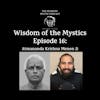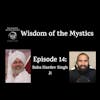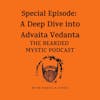Thoughts on the Bhagavad Gita (Chapter 14: Verses 1 - 5)
In this episode of The Bearded Mystic Podcast, Rahul N Singh continues his discourse on the Bhagavad Gita, focusing on Chapter 14 verses 1 to 5. It delves into the transcendence of the three gunas (Sattva, Rajas, Tamas) and how they bind the Atma to the body. Rahul explains these verses in the context of both Sankhya philosophy and Vedanta, illustrating how these gunas influence human consciousness and effect the reincarnation cycle. The podcast also serves as a platform for a wider discussion about meditation, liberation, and the knowledge of Brahman.
Translation used: The Bhagavad Gita Comes Alive: A Radical Translation by Jeffrey Armstrong
If you enjoyed listening to the 90th episode of the Thoughts on The Bhagavad Gita and want to listen to more episodes like this on the Bhagavad Gita, or on Non-Duality, or the wisdom of the Mystics please follow/subscribe to this Podcast. New episodes are uploaded every Sunday.
Thoughts on the Upanishads, Conversations with the Bearded Mystic, Guided Meditations, and much more only on Patreon, Buzzsprout Subscriptions, Apple Podcast Subscriptions and Supercast.
Patreon: Support The Bearded Mystic Podcast and get ad-free, bonus episodes along with many more benefits:
https://www.patreon.com/thebeardedmysticpodcast
Join The Bearded Mystic Podcast Discussion Group on Whatsapp: https://chat.whatsapp.com/GcCnyrjQwLuEPHBaVA6q9L
Be notified of my weekly virtual meditation session followed by a Q&A Discussion via zoom (Notifications only):
https://chat.whatsapp.com/DcdnuDMeRnW53E0seVp28b
Please rate and write a review for this Podcast: https://www.thebeardedmysticpodcast.com/reviews/new/
You can follow me and contact me on social media:
Website: https://www.thebeardedmysticpodcast.com
TikTok: https://vm.tiktok.com/ZMdk3HPJh/
Instagram: https://www.instagram.com/thebeardedmysticpodcast/
Youtube: https://www.youtube.com/c/TheBeardedMysticPodcast/
Twitter: https://twitter.com/bearded_mystic
Facebook: https://www.facebook.com/The-Bearded-Mystic-Podcast
Rahul N Singh:
Hello and welcome to The Bearded Mystic Podcast and I'm your host Rahul N Singh. Thank you for taking out the time today to either watch or listen to this podcast episode. If you are really interested in supporting The Bearded Mystic Podcast, and you've found great benefit in listening or watching these episodes, then please do support this podcast on Patreon where you can get ad free and bonus episodes along with other benefits depending on the tier that you select. Your support means everything, and it really does help the podcast keep running efficiently and smoothly, and also widens the audience that this message can reach to. If you would like to know more about it, the details are in the show notes and video description below. On Saturdays at 11:00 AM Eastern Standard Time there is a free virtual meditation session along with discussion and Q&A. If you're interested in meditating with us as a community, then you can find out the details in the show notes and video description below. Please do like, comment, and subscribe if you're watching this on YouTube and if you're listening to this on your favorite podcast streaming app, then please do give this podcast a five star rating. It helps the podcast get up in the charts and allows the algorithm to bring this podcast to new listeners and also do review the podcast if you can and make sure you do follow or subscribe to keep getting future episodes. Today we will be continuing on with my thoughts on the Bhagavad Gita and most of all we'll be starting a new chapter which is chapter 14 which is going to be about the transcendence of the three gunas and specifically we'll be looking at chapter 14 verses 1, to verses 5. So let's get started with verse 1. Sri Bhagavan said, Now I will again reveal to you the highest transcendental knowledge by which great munis in the past have gone beyond their limitations, achieved perfection, and attained the supreme and ultimate destination. So we're going to look at the verse as a whole here. Sri Krishna mentions that he's going to be revealing the highest transcendental knowledge and this as his words say, he is again going to be revealing it. So this means that it's been mentioned before. Now this is another opportunity for us to capture the Highest Truth and achieve the benefits and the fruits of going beyond these three gunas. Or most of all, by attaining this transcendental knowledge and implementing it into our own life. This knowledge obviously is how Munis go beyond their body and mind and we know these Munis are great liberated beings and one thing is that it tells them that it goes beyond their limitations so they're not limited within nature and they've achieved perfection because they realize they are this witness consciousness, this Brahman and they've attained the supreme and ultimate destination which is liberation, which is Moksha or freedom. It's allowed them to complete their evolution in life. This is what it's all about and once you've attained that supreme and ultimate destination of formless awareness, which is freedom, which is the transcendence of body and mind identification, and where we can rest the true I in the true I ness of this existence, which is Brahman, that is where we will be going, and that's what Sri Krishna means by this highest transcendental knowledge is going to be revealed again, and the Munis in the past have attested to this knowledge. They are the experience, they are the, uh, you could say the study, or the peer review, that's happened in the past. Verse 2. When the Jiva-Atman embraces this Gyan, they achieve a state of being very much like my own. The long term effect of that knowing is that when this world is again created, they are not reincarnated. And when the world is finally destroyed, they have nothing to fear. A very deep verse and let's break this one up. When the Jiva-Atman embraces this Gyan, they achieve a state of being very much like my own. So once this Jiva-Atman, so the witness consciousness within that right now has limited itself to the body and mind and has not identified as pure consciousness. When it embraces this knowledge, when it embraces the knowledge that it is not the body and mind, and that it is this witness consciousness, this formless awareness, this Brahman, when it has that knowledge revealed to it, then it achieves the same state as Sri Krishna. Meaning, they, as Sri Krishna is free. So is that Jiva-Atman. So what happens is our consciousness remains as itself rather than mixing itself with body and mind. That does not mean that Prakriti will not act while the Jiva-Atman inhabits it, but it does not identify it. So the Jiva has to fully embrace this Gyan, this knowledge that it is this witness consciousness, it is this formless awareness and that's it. It is the Purusha. not the prakriti. What is this Gyan that is embraced? As we mentioned, it's the knowledge of Brahman, this Brahm Gyan, and once the Jiva understands, and the Brahm Gyan is basically where one is revealed that there is only Brahman, and that everything around us, everything amongst us, even this name and form, and even this Jiva, is none other than this Brahman itself, there's only this one reality, And that's what the Brahm Gyan reveals. And then Sri Krishna adds in that verse that the long term effect of that knowing is that when this world is again created, they are not reincarnated, and when the world is finally destroyed, they have nothing to fear. This is pretty much straightforward. The long term effect of that realization, once one is able to fully transcend the body and mind, and associate oneself as Brahman, then what happens is, even if the world is created again, they are not reincarnated. They do not come back into this world. Because they have broken free from the limitations of name and form. And so, again, when the world is finally destroyed again, which will eventually happen, they have nothing to fear because they have transcended the limitations. They have transcended and become free. And this is essentially what we need to try and achieve, is to be in freedom. So the reason is simply that they've transcended it all, and that the universe and this world will go through a cycle of creation and dissolution for eternity. So this will continuously happen. And most of all, the Jiva Atma realises that they are Brahman, and that's why they cannot be reincarnated again. If they are Brahman, what do they have to fear? If there is only this one reality, where is the fear of duality? It does not occur. The ultimate realisation is that even if this world gets destroyed, even if Prakriti is destroyed, it doesn't matter because that is not who I truly am, that is not my true self, that is what the Gyani realises and that is the path of the Gyani, that is the path that they take that has been, like I mentioned, tried and tested. We know that this world will go through a dissolution and then we'll come back again. This has been mentioned before as well. So Sri Krishna is just re emphasizing this point. Then verse 3. Oh Arjuna, just as two persons produce a child, so the transcendental realm of Brahman acts as a kind of cosmic yoni, womb, into which I implant the garbha, the seedling forms, of the countless atmas, who are then born within prakriti as living beings. So first of all, we have to understand the philosophy of Sankhya here. So Sankhya says there's infinite Purushas and there's infinite Prakriti, or Prakriti is actually more or less one. Now, once you understand that Prakriti is unreal because it's changing, then the Purusha which is real because it's changeless. But what Sankhya does is that it says that there's countless witness consciousnesses. Now Vedanta takes it a step further and says actually, not only is prakriti one. We accept this. We also accept that the Purusha is one. Actually, it just appears as many. And even prakriti appears as many. The cause of it is all Brahman. Sri Krishna here uses the example of producing a child. Now we know that when two persons produce a child, so when there's a womb, when there is an egg, and there is a, the sperm cell, the sperm, seed, those two things are required for a child to be born, for a child to be produced for the fetus to grow and become a child. So Sri Krishna is using that analogy to make us understand that the transcendental realm of Brahman is basically a kind of cosmic yoni. So this prakriti we see is actually a yoni, a womb, and when this womb is then mixed with consciousness then you see this world, then you see prakriti, then you see this maya that is, then you see shakti, so you need shiva and you need shakti, you need Brahman and you need maya. What it says here is Brahman acts as a kind of cosmic yoni, so cosmic womb, so what it means here is that It is the underlying cause of all creation, so without this Brahman, there is no creation, there is no aspect of this world being created, so this Brahman is very much needed in order for creation to be. And then he says, there's this womb and into which I implant the garbha, the seedling forms. So here, where we see these many jiva atmas, they are basically seedling forms. And Sri Krishna says, there's countless of them. You cannot put a number to them. And they are born within prakriti as living beings. Now, a way I can explain it as well, another way, is that You can see the cosmic yoni as the shared being or Ishwara, the generator, the destroyer and sustainer. You can see it as that. So you can see the Shared Being or the Ishwara as kind of a womb that acts like a womb and that Brahman itself or you could say the Ishdevta implants seedling forms of countless Atmas, someone like Sri Krishna, or you can see the other way around where Brahman is the womb and you have the Ishwara implant seedling forms of countless Atmas, so there's many ways you can see it, but in my opinion the best way to see it is Brahman is the cosmic yoni and Sri Krishna or Ishwara are the The ones that implant the garbhas, the seedling forms. And the one way to have a look at this is, if you remember watching The Matrix, and you see in The Matrix, when Neo has to awaken, when he's kind of like born again, you see this place where there's many, many, pods of, people in them. And that's kind of what you can imagine here. It's kind of like you have this whole building or this room where there's many wombs or there's this womb, this massive womb and in there you have these garbhas, these seedling forms in each pod and basically, once they are awakened, they are born within Prakriti as living beings so these Atmas then become Jiva Atmas When they are born in prakriti. So when they mixed with nature, this is what happens. So basically what we understand from this is you have Brahman when it mixes with name and form, it produces prakriti or us as human beings. So ultimate thing to remember is that Brahman is the creator, the sustainer, and eventually the destroyer. Verse 4. Listen Arjuna, of all the material wombs from which the many forms of material life emerge, know that the great womb of Brahman is their actual source, and I am the seed giving father of all embodied life. So literally just re emphasizing what I've talked about. Again, he wants Arjuna to really understand what he's talking about. We need to understand it personally, carefully ourselves. As Sri Krishna is explaining how the gunas have come to be, and more so how life came to be. And it's very similar to what we know of life. We know that two things need to mix together in order for life to be. So, you have all the rooms in which many life forms emerge. All the animals and humans and so on. And all of this is created within the great womb of brahman so basically you can see like this it's the we are the wombs within the womb itself so anything that has a life and another one thing to remember is this shows the power of the feminine. This also shows the power of creation, this also shows the power of shakti, And why we should respect maya too, even though maya can trap us but we should understand that this mahamaya, this shakti is able to help us transcend as well. It gives us hints on how to transcend and it's all come from this Brahman itself. So why should we condemn it? We should be wary of it. We should be alert about it, but we don't have to condemn it. We don't have to be negative about it. We can see what it's trying to do, we can see what it's trying to achieve, that's it. Here he mentions that the underlying existence is Brahman. This should be absolutely understood by now. That the underlying cause, underlying existence of everything is Brahman, this formless awareness. And without this awareness, no name and form can appear, nothing can be seen as objects. It is the eternal subject, everything around it that has a name and form is an object. Without the source, none of this existence would be here, so everything needs a source of existence and this is what Sri Krishna is talking about. So remember that Brahman is the ultimate source of existence. Sri Krishna, again, is the same as Brahman here. We have to understand that they are one and the same and whenever someone becomes liberated and free, they become the same as Brahman. So there's no, no reason for us to be under the delusion that there is separation here between Sri Krishna and Brahman. But to illustrate the point, he highlights that the seed for this creation to appear is Ishvara, or the Shared Being, or Sri Krishna. That's just to say, two things need to intermingle for existence to occur, and basically, it's all one. It's all emanating from the one. So the many forms that you see, is really just this one Brahman itself. Do not fall under the delusion that they're separate things. They are one. This is really a way, uh, again, Sri Krishna is telling us how there is oneness. We may not be quick enough to understand this unless we have gone through the whole process of understanding nature, of studying, you know, the whole process of Shravana, Manana, Nidhidhyasana, so Shravana, listening, Manana, reflecting. Nidhidhyasana integrating and meditating. So that will take time for us, obviously, but we need to do this when we're looking at verses like this. The seed giving father as mentioned is Sri Krishna or the Shared Being or Ishwara. And due to this, the Jiva embodies the life form it inhabits. It is from Nirguna, from Saguna Brahman, that when the Jiva embodies a life form, it is becomes an embodied being. So without the jiva, there is no embodied being. So the jiva atma is very much necessary and what happens is the jiva atma, although it is Brahman, although it is the seed giving father, even though that's what his true nature is, even though his true nature is the source of this existence, it can go into delusion of thinking it's the body and mind and or the The anybody that it creates or the name and form that it inhabits. And that's because of the gunas which we'll discuss in a minute. Because the jiva source and the source of the life forms is Brahman, it is ultimately free too, but this is not what he's saying. All we can say is that embodied life is there because of the jiva and also because of Brahman for all of these forms that to exist, we need the great womb of Brahman and we need to understand that the seed giving father of all embodied life is Sri Krishna or Ishwara or any of the deities that we really respect, Shiva, Shakti, same thing. Then verse five, which is the last verse of today's episode. Three gunas, sattva, rajas, and tamas, are the three dynamic states of prakriti, which, like ropes or strings, bind the dehi, the atma, to the deha, the five element body within matter. This is a very important verse. Why is it important? The important aspect of this verse is that it tells you how consciousness which is pure in itself gets mixed into prakriti and falls under delusion. We'll look at the whole verse together and then we'll expand upon each thing. So the three gunas bind the Atma or the jiva to the body. What happens here, the Jiva is pure in its state. Then it what happens when it has a body. Then sattva, rajas and tamas bind the atma towards prakriti, to name and form So when these three, dynamic states of prakriti work together, they are like rope or strings. So that's the way to see it. And remember, all of us have a mixture of the three gunas. Yeah, all of us. All of us have sattva, rajas and tamas. Just some are more predominant than the others and Sri Krishna would go into that in this chapter. And these three dynamic states means they're always in flux, hence there's always one guna that's more predominant. And we may be going through each one, so one time tamas may be predominant, another day rajas, another day sattva is. And basically, as we know, ropes and strings bind things together. Say we have a bunch of pens and we want to make sure they stay together. And if not, we will lose a pen. So what happens is we bind it together with a piece of string. or a piece of rope, or we have a load of wood, and we've collected wood, and to keep them together, we bind it together with a piece of rope. Likewise, this sattva, rajas and tamas, they bind the body together. So these gunas bring the jiva and the body together, the atma and the body together and when this consciousness mixes in with prakriti, with name and form, it creates a separate mind, a separate reality and therefore we lose our, we lose the awareness that we are awareness itself. We bypass the most obvious of it as we're living life. Here guna means a substance that binds and just to note that the gunas have no separate existence but they are part of prakriti itself, without prakriti they do not exist, they exist because of prakriti and prakriti is made up of this. The three gunas have countless explanations modifications, like some are more tamsik, some are more sattvic, some are more rajasic, and there are a great number of modifications that people inhabit when they are born. In fact, Sri Ramakrishna mentions that for five years, none of the gunas are predominant. You know, a child is always free, but eventually, um, one According to nature and nurture, one goes into one mode. It is the three gunas that hides the true essence of ourself, which is this consciousness. We bypass awareness, we bypass consciousness, we bypass the subject because we think we're an object and we fall in love with objects. And, but, it's through investigation we understand that this jiva can become free from its hold from prakriti. We start understanding that actually, our consciousness has gone mixed in with this five element body within matter and it's these gunas that are binding it together. How can one break free from that? That is what Sri Krishna is going to address in the next episode. So what we can see from today's episode, just as a quick recap, is how one, we're going to be told this transcendental knowledge again. So this whole knowledge is going to be revealed to us. But the other aspect is that Sri Krishna is going to be telling us how we can become free from it like others have done in the past. So we don't have to remain restricted in this name and form for too long. So that is the end of today's episode. Thank you very much for listening. If you liked what you heard and liked what you watched, please do share this podcast with your friends and family who may enjoy this content. Do follow me on social media to keep getting updates. Join the Bearded Mystic Podcast WhatsApp community group to continue the podcast discussion, details are in the show notes and video description below. If you would like to support the Bearded Mystic Podcast as we discussed earlier, do check out the podcast Patreon page. Your support means everything, and it helps this podcast keep running. Details are in the show notes and video description below. Please do rate this podcast five stars and do give a review either on your favorite podcast, streaming app or on our website. Details are in the show notes and video description below. Please do like and comment on this video and subscribe to this YouTube channel. Do follow or subscribe to this podcast on your favorite podcast streaming app. Thank you very much for listening to this episode. Let's end with the Shanti mantra and the Soham mantra. Soham Soham. I am That. I am That. Aum Shanti Shanti Shanti Aum Peace Peace Peace
New to The Bearded Mystic Podcast?
Here are some great episodes to start with. Or, check out episodes by topic.















